Galls or cecidia are a kind of swelling growth on the external tissues of plants. Plant galls are abnormal outgrowths of plant tissues, similar to benign tumors or warts in animals. They can be caused by various parasites, from viruses, fungi and bacteria, to other plants, insects and mites. Plant galls are often highly organized structures so that the cause of the gall can often be determined without the actual agent being identified. This applies particularly to insect and mite plant galls. The study of plant galls is known as cecidology.
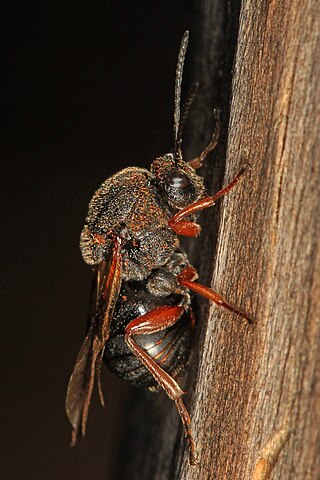
Gall wasps, also traditionally calledgallflies, are hymenopterans of the family Cynipidae in the wasp superfamily Cynipoidea. Their common name comes from the galls they induce on plants for larval development. About 1,300 species of this generally very small creature are known worldwide, with about 360 species of 36 different genera in Europe and some 800 species in North America.
Herbivores are dependent on plants for food, and have coevolved mechanisms to obtain this food despite the evolution of a diverse arsenal of plant defenses against herbivory. Herbivore adaptations to plant defense have been likened to "offensive traits" and consist of those traits that allow for increased feeding and use of a host. Plants, on the other hand, protect their resources for use in growth and reproduction, by limiting the ability of herbivores to eat them. Relationships between herbivores and their host plants often results in reciprocal evolutionary change. When a herbivore eats a plant it selects for plants that can mount a defensive response, whether the response is incorporated biochemically or physically, or induced as a counterattack. In cases where this relationship demonstrates "specificity", and "reciprocity", the species are thought to have coevolved. The escape and radiation mechanisms for coevolution, presents the idea that adaptations in herbivores and their host plants, has been the driving force behind speciation. The coevolution that occurs between plants and herbivores that ultimately results in the speciation of both can be further explained by the Red Queen hypothesis. This hypothesis states that competitive success and failure evolve back and forth through organizational learning. The act of an organism facing competition with another organism ultimately leads to an increase in the organism's performance due to selection. This increase in competitive success then forces the competing organism to increase its performance through selection as well, thus creating an "arms race" between the two species. Herbivores evolve due to plant defenses because plants must increase their competitive performance first due to herbivore competitive success.
The gall adelgid is an adelgid species that produces galls in spruce trees. They infect the new buds of native spruce trees in the foothills of the Rocky Mountains in the spring. They also attack blue spruce to a lesser degree. The insects complete two generations within the year. They require two different trees for its life cycle, the second being the Rocky Mountain Douglas-fir. They may also attack Sitka, Engelmann, or white spruce. The many different species of adelgids produce different galls on different spruce species.
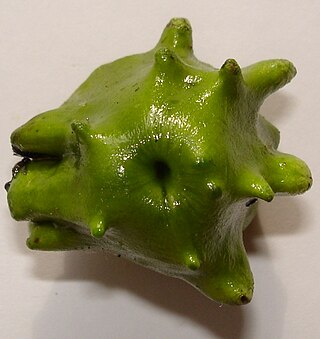
Andricus quercuscalicis is a gall wasp species inducing knopper galls.

Andricus kollari, also known as the marble gall wasp, is a parthenogenetic species of wasp which causes the formation of marble galls on oak trees. Synonyms for the species include Cynips kollari, Andricus quercusgemmae, A. minor, A. indigenus and A. circulans.

Andricus foecundatrix is a parthenogenetic gall wasp which lays a single egg within a leaf bud, using its ovipositor, to produce a gall known as an oak artichoke gall, oak hop gall, larch-cone gall or hop strobile The gall develops as a chemically induced distortion of leaf axillary or terminal buds on pedunculate oak or sessile oak trees. The larva lives inside a smaller hard casing inside the artichoke and this is released in autumn. The asexual wasp emerges in spring and lays her eggs in the oak catkins. These develop into small oval galls which produce the sexual generation of wasps. A yew artichoke gall caused by the fly Taxomyia taxi also exists, but is unrelated to the oak-borne species. Previous names or synonyms for the species A. fecundator are A. fecundatrix, A. pilosus, A. foecundatrix, A. gemmarum, A. gemmae, A. gemmaequercus, A. gemmaecinaraeformis and A. quercusgemmae.

Diplolepis rosae is a gall wasp which causes a gall known as the rose bedeguar gall, bedeguar gall wasp, Robin's pincushion, mossy rose gall, or simply moss gall. The gall develops as a chemically induced distortion of an unopened leaf axillary or terminal bud, mostly on field rose or dog rose shrubs. The female wasp lays up to 60 eggs within each leaf bud using her ovipositor. The grubs develop within the gall, and the wasps emerge in spring; the wasp is parthenogenetic with fewer than one percent being males.
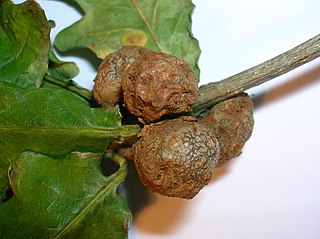
Cola-nut galls develop as a chemically induced distortion of leaf axillary or terminal buds on pedunculate oak or sessile oak trees, caused by the agamic gall wasp Andricus lignicola which lays single eggs within leaf buds using their ovipositor. A previous name or synonym for the species A. lignicola is A. lignicolus and A. venheurni.

The common spangle gall on the underside of leaves and the currant gall on the male catkins or occasionally the leaves, develop as chemically induced distortions on pedunculate oak, or sessile oak trees, caused by the cynipid wasp Neuroterus quercusbaccarum which has both agamic and bisexual generations.
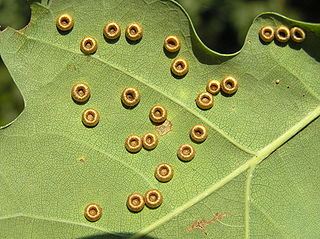
Neuroterus numismalis is a gall wasp that forms chemically induced leaf galls on oak trees. It has both bisexual and agamic (parthenogenetic) generations and forms two distinct galls on oak leaves, the silk button gall and blister gall. The galls can be very numerous with more than a thousand per leaf.
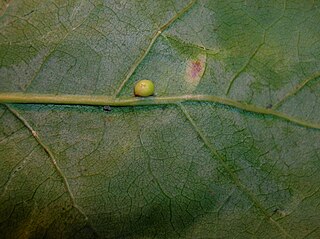
Neuroterus anthracinus is a widely distributed gall wasp that forms chemically induced leaf galls on oak trees. N. anthracinus has both sexual and agamic generations and in consequence forms two distinct galls, the oyster gall and April-bud gall.

Cynips is a genus of gall wasps in the tribe Cynipini, the oak gall wasps. One of the best known is the common oak gall wasp, which induces characteristic spherical galls about two centimeters wide on the undersides of oak leaves.

Cynips quercusfolii, also known as the cherry gall wasp, is a gall wasp species in the genus Cynips and family Cynipidae. The species is important for the production of commercial nutgall formed on Quercus lusitanica . Galls are located on the underside of leaves, with the majority of galls being on the second and third veins from the petiole of the leaf.

Andricus grossulariae is a gall wasp species inducing agamic acorn cup galls on oak tree acorn cups and sexual phase galls on catkins. Synonyms include Andricus fructuum, Andricus gemellus, Andricus intermedius, Andricus mayri and Cynips panteli.

The pineapple gall adelgid is a species of conifer-feeding insect that forms pineapple-shaped plant galls on its host species, commonly Norway and Sitka spruce. The adelgids are pear-shaped, soft-bodied green insects with long antennae, closely related to the aphid. Adelges lays up to one hundred eggs at a time, one on each needle. Adelges abietis is one of the most common species; synonyms are A. gallarum-abietis, Chermes abietis and Sacciphantes abietis.

The goldenrod gall fly, also known as the goldenrod ball gallmaker, is a species of fly native to North America. The species is best known for the characteristic galls it forms on several species in the Solidago, or goldenrod, genus. The fly's eggs are inserted near the developing buds of the plant. After hatching, the larvae migrate to an area below the plant's developing buds, where they then induce the plant's tissues to form into the hardened, bulbous chamber referred to as a gall. E. solidaginis’s interactions with its host plant(s) and insect, as well as avian, predators have made it the centerpiece of much ecological and evolutionary biology research, and its tolerance of freezing temperatures has inspired studies into the anti-freeze properties of its biochemistry.

Andricus inflator is a species of gall-forming wasps, in the genus Andricus, which has a sexual and an asexual generation, producing two different galls. The wasp was named by the German biologist Theodor Hartig, in 1840 and is found in Europe.

Cynips quercusechinus, the urchin gall wasp, is a species of gall wasp in the family Cynipidae. It induces galls in the leaves and leaf buds of blue oak and scrub oak. Like other oak gall wasps, it has two generations: a bisexual generation, and a parthenogenic female generation. In spring, the hatching bisexual generation produces hollow green galls in leaf buds. In summer, the unisexual generation induces its galls, which are red or pink and resemble sea urchins, on the undersides of leaves. These galls are about 10 millimetres (0.39 in) in diameter. The galls fall with the leaves in autumn, and the larvae inside of them emerge as adults in the spring and lay their eggs.

Disholcaspis quercusmamma, the oak rough bulletgall wasp, is a species of gall wasp in the family Cynipidae. The quercus in its name is the genus name for oak, while "mamma" is Latin for "breast", presumably a reference to the "nipple" on the gall.

















